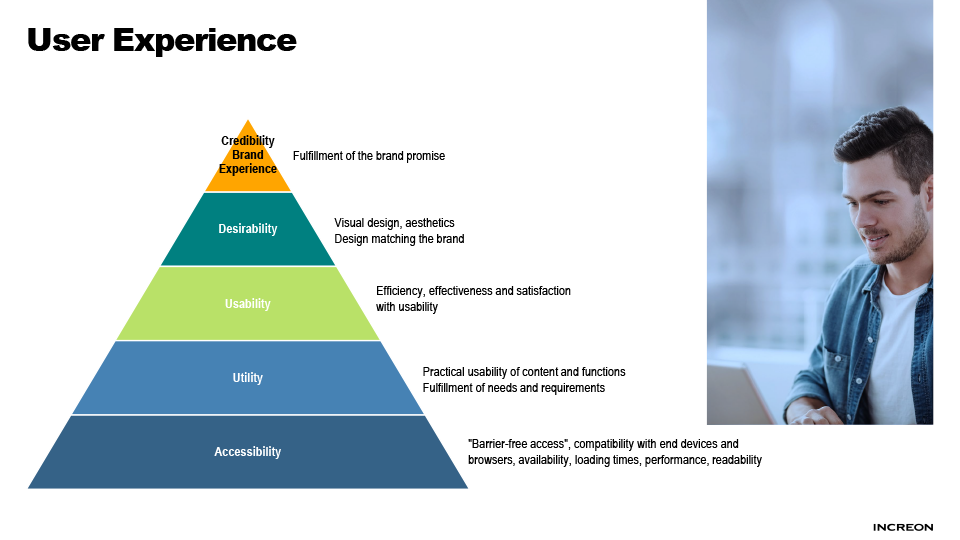User Experience (UX)
In an online world where users decide in seconds whether they want to stay on a website, download an app or buy a product, user experience (UX) is a key success factor for websites, apps, customer portals, products and services. When users have countless options, the first impression is crucial – and it doesn’t get a second chance.


B2B USER EXPERIENCE (UX).
The first impression counts.
The easiest way to compare the importance of an initial positive user experience for the subsequent decision-making or purchasing process is to visit a department store or supermarket. If the products are clearly arranged, the shelves are clearly labeled and everything is easily accessible, the prospective customer or customer will easily find what they are looking for. If you compare this to a website, an app or a customer portal, it means that the pages load quickly, navigation is intuitive and the content is clearly structured. Just as customers have a pleasant shopping experience in a well-stocked supermarket, visitors to a well-designed website will have a positive user experience (UX).
More than just user-friendliness
User experience encompasses far more than just user-friendliness. For us as a digital consultancy, user experience (UX) refers to the totality of impressions and sensations that a user experiences when interacting with a website, app, product or service. In addition to purely factual or technical factors such as user-friendliness, design, functionality and accessibility, this also includes the user’s emotional reaction in particular. A positive user experience aims not only to fulfill functional needs, but also to generate positive emotions and satisfaction, taking into account the entire spectrum of user interaction – from navigation and design to emotional resonance.
We have several 1,000 touchpoints with different brands and companies every day. We remember less than 10 of them. It takes more than 8 of these touchpoints along the B2B customer journey before the first contact is made. With so much digital information, the concept of “first impressions count” becomes even more important for us as a digital agency. Companies must ensure that their digital platforms and products make a positive impression from the very first contact. This is the only way they can be remembered in the multitude of daily touchpoints with a wide variety of brands and companies.
HOW CAN USER EXPERIENCE (UX) BE MEASURED?
When measuring the user experience of a website, app or digital application, there are more objective factors such as conversion rate, bounce rate, dwell time or loading times, and more subjective factors that are decisive for a good user experience. In user experience consulting, we look at these measurable factors:
Accessibility: “Barrier-free access” forms the basis of a good user experience (UX). How easily can people with different abilities understand and use the website or application? Does the application or website work on the devices and browsers relevant to the target group? Are loading times and performance adequate for users and the application? In addition to these “technical factors”, readability, i.e. comprehensibility, also plays an important role for us in user experience (UX) consulting.
Utility: This is about the practical usability of the content or functions for the user, i.e. ensuring that the website or app meets the needs and requirements of the target group. This can be measured by KPIs such as conversion rates, completion of tasks or the achievement of goals.
Usability: Usability measures the efficiency, effectiveness and satisfaction with which users can perform certain tasks on a website or in an app. KPIs such as dwell time, the number of clicks to the destination, the completion rate of forms or the success rate of certain interactions (e.g. search) can quantify usability.
Desirability: The measurability of aesthetics in the context of user experience (UX) refers to visual design and appeal. While aesthetics are more subjective than other aspects, KPIs such as visual ratings from users, heat maps, eye-tracking studies or the use of design guidelines can still be used to measure aesthetic quality.
Credibility/brand experience: For us as a B2B branding agency, brand experience is a key factor in good user experience. Does the website or application fit the brand? Does it fulfill the brand promise? Does it pay into the brand in the long term?
Designing the B2B user experience (UX)
For us as a digital consultancy, designing an outstanding user experience (UX) for websites, apps and digital solutions depends on four success factors that ensure seamless and effective interaction along the entire customer journey.
User-centered approach
The basis for our user experience (UX) consulting is the focus on the user along the entire customer journey. This means understanding and taking into account the needs, expectations and behaviors of users at every stage of the interaction. The task: to offer users exactly what they need and positively influence their experience.
Holistic view
Successful user experience (UX) consulting also takes all aspects of user interaction into account. This includes the overall design, navigation, information and content architecture as well as technical performance. User surveys, A/B tests, eye tracking studies or click prototypes can provide information here. The integration of all these factors into a seamless unit is crucial for a coherent and satisfying user experience.
Iterative optimization
The third pillar of user experience (UX) consulting is continuous improvement. By analyzing user data, feedback and interaction patterns, weaknesses and opportunities for improvement can be identified. This iterative approach makes it possible to continuously adapt websites and digital solutions in order to constantly optimize the user experience and adapt to changing requirements.
Multidisciplinary collaboration
Finally, cooperation between different specialist departments at our digital agency and at the customer’s plays a decisive role for us in consulting. After all, the user experience doesn’t stop when you click on the contact button. This multidisciplinary approach guarantees comprehensive solutions that are both functionally and emotionally convincing and increase user satisfaction – beyond the digital world.




